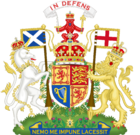Tenements (Scotland) Act 2004 facts for kids

|
|
| Long title | An Act of the Scottish Parliament to make provision about the boundaries and pertinents of properties comprised in tenements and for the regulation of the rights and duties of the owners of properties comprised in tenements; to make minor amendments of the Title Conditions (Scotland) Act 2003 (asp 9); and for connected purposes. |
|---|---|
| Citation | 2004 asp 11 |
| Introduced by | Margaret Curran, Minister for Communities |
| Territorial extent | Scotland |
| Dates | |
| Royal assent | 22 October 2004 |
| Commencement | 28 November 2004 |
| Other legislation | |
| Relates to | Abolition of Feudal Tenure Etc. (Scotland) Act 2000, Title Conditions (Scotland) Act 2003 |
|
Status: Current legislation
|
|
| History of passage through Parliament | |
| Text of statute as originally enacted | |
| Revised text of statute as amended | |
The Tenements (Scotland) Act 2004 is an important Act of the Scottish Parliament. An Act is a law passed by the government. This law helps manage "tenement flats" in Scotland.
Tenement flats are a common type of home in Scotland. They are usually large buildings divided into several separate homes, one above the other. This Act sets out the rules for how these flats are owned and managed.
This law is part of a bigger plan to update land rules in Scotland. It works alongside other laws like the Abolition of Feudal Tenure etc. (Scotland) Act 2000 and the Title Conditions (Scotland) Act 2003. All these laws started on 28 November 2004.
Contents
What is a Tenement?
The Tenements (Scotland) Act 2004 helps us understand what a tenement is. Section 26 of the Act says a tenement is a building with two or more separate homes. These homes are stacked on top of each other.
This definition is quite broad. It includes not only traditional tenement buildings. It also covers other types of homes. For example, it includes "four-in-a-block" houses. These are four homes joined together. It also covers larger houses that have been split into smaller flats.
Who Owns What?
The Act has clear rules about who owns different parts of a tenement building. This helps prevent arguments between neighbours.
Owning the Roof and Ground
- If you own the top-floor flat, you also own the roof above it. You own the space in the loft too. This is stated in Section 2(3) of the Act.
- If you own the ground-floor flat, you own the land directly beneath your flat. This land is called the solum. This rule is in Section 2(4). It also covers the land in front of and behind your flat.
- The close is a common area, like a shared hallway or stairwell. Section 2(5) says that the close, including the ground beneath it and the roof above it, is owned by everyone who uses it.
- Section 3 says that if a close or lift serves your flat, you have a shared ownership right in it. This means you and your neighbours all own it together.
Air Space Ownership
- Section 2(6) explains that if you own the ground beneath any part of the property, you also own the air space above it. This includes the air space above the roof of the top-floor flat.
- However, Section 2(7) adds a detail. If the roof has a slope, the owner of the roof also owns the air space above that slope. This applies even if it's below the highest point of the roof.
Responsibilities of Owners
The Act also explains what owners must do. It makes sure that everyone helps look after the building.
Keeping the Building Safe
- Section 8 says that owners must maintain parts of their property that support or shelter other parts of the building. For example, if your wall supports your neighbour's floor, you must keep it in good repair.
- Section 9 states that owners cannot do anything to their property that would harm the building. This means you cannot damage the support or shelter for other flats. You also cannot block natural light for other parts of the building.
What Happens if a Tenement is Demolished?
The Act has rules to protect owners if a tenement building is torn down.
- Section 20 says that if the building is demolished, owners still keep their ownership rights. This includes the air space where their flat used to be. They also keep any shared land, like a driveway or close.
- Section 21 explains how money from demolition is shared. Usually, profits are divided equally among owners. But if the flats are very different in size (the largest is more than 1.5 times bigger than the smallest), profits are shared based on the size of each flat.
- Section 22 puts limits on what can be done with the land after demolition. This applies when different owners still have rights to the site.
- Section 23 allows an owner to ask for permission to sell an abandoned tenement. This can happen in certain situations.
See also

